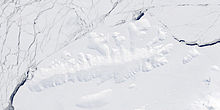Thurston Island
 | |
| Geography | |
|---|---|
| Location | Antarctica |
| Coordinates | 72°6′S 99°0′W / 72.100°S 99.000°W |
| Area | 15,700 km2 (6,100 sq mi) |
| Area rank | 56th |
| Length | 215 km (133.6 mi) |
| Width | 90 km (56 mi) |
| Highest elevation | 750 m (2460 ft) |
| Administration | |
None | |
Thurston Island is an ice-covered, glacially dissected island, 215 km (134 mi) long, 90 km (56 mi) wide and 15,700 km2 (6,062 sq mi) in area, lying a short way off the northwest end of Ellsworth Land, Antarctica. It is the third largest island of Antarctica, after Alexander Island and Berkner Island.

Thurston Island is separated from the mainland by Peacock Sound, which is occupied by the western portion of Abbot Ice Shelf.[1] It divides Bellingshausen Sea to the east from Amundsen Sea to the west.
The island was discovered from the air by Rear Admiral Byrd on February 27, 1940, who named it for W. Harris Thurston, New York textile manufacturer, designer of the windproof "Byrd Cloth" and sponsor of Antarctic expeditions.
Originally charted as a peninsula, the feature was not recognised an island until 1960.[1]
See also
- Porters Pinnacles
- Composite Antarctic Gazetteer
- List of Antarctic and sub-Antarctic islands
- List of Antarctic islands south of 60° S
- Scientific Committee on Antarctic Research
- Territorial claims in Antarctica
References
- ^ a b "Antarctic Gazetteer: Thurston Island". Australian Antarctic Division. Retrieved 2008-01-26.
External links
![]() This article incorporates public domain material from "Thurston Island". Geographic Names Information System. United States Geological Survey.
This article incorporates public domain material from "Thurston Island". Geographic Names Information System. United States Geological Survey.
